Mpox

Mpox (monkeypox) is a viral disease caused by the monkeypox virus, a species of the genus Orthopoxvirus. The Mpox occurrence and symptoms:
Effectively value and fund provision and delivery of outreach, sexual health education and prevention services alongside the clinical service.
Charities of all sizes have financial challenges and MyHealthnet is not alone, but we have relentlessly suffered resource shortages by any measure. We are also aware that councils have had to prioritise clinical activity over prevention in many areas. Unlike STI testing treatment and contraception, they are not services that councils are mandated by law to provide. The funding for prevention services has been reduced as a result of cuts to the public health grant, meaning that outreach services for groups such as sex workers, and rough sleepers, known to have poorer sexual health outcomes have been stripped back. Cuts to these services leave these vulnerable populations increasingly exposed to poorer sexual health outcomes.
We must continue to work across society to tackle HIV through prevention, education, awareness, and increased access to testing, enabling early diagnosis and treatment. We want to take part in more progressive clinical services to support users in need while ensuring equitable access to prevention interventions, from condoms to HIV Pre-Exposure Prophylaxis (PrEP) so that it benefits all groups at greater risk of HIV. Prevention is a key strand of the National HIV Action Plan[iv] and directly contributes to its targets and ambitions. However, we are exploring how we can provide this service while our walk-in services are closed.
Social media platforms and online interventions provide opportunities for sexual health promotion. Public health campaigns can leverage social media to disseminate accurate information, raise awareness about STI prevention, and encourage individuals to seek testing and treatment. Campaigns are a useful tool to potentially counter misinformation.
Although we are in 2024m we welcome the National Women’s Health Strategy launched in July 2022. The strategy indicates an approach to reduce inequalities and disparities in health outcomes affecting women. We fully support taking a life course preventative approach to improving access and care for women, who represent 51 per cent of the population. We call for the continuation of the Women’s Health Strategy which we hope will align with a new sexual and reproductive health strategy.
A consistent fall in teenage pregnancies over the last 10 years, down to the lowest rate since 1969, is a testament to the systematic application of successful strategies implemented by local authorities, including education, support, and access to comprehensive sexual health services. There remains substantial variation in rates between councils, continued focus is required to maintain this downward trend, particularly where there are persistent high rates linked to multiple deprivation indicators.
Over the last 10 years, there have been significant innovations in using technology to support sexual and reproductive health services. The imperative for local public services to fully exploit the potential of modern digital tools, technologies, and approaches to improve delivery and save money has never been greater. We face rising citizen demand, needs and expectations at a time of severe spending and resource constraints.
Promoting hybrid service innovation – such as online STI testing and HIV self-sampling being adopted across the sector, successfully transforming the citizen experience, and reducing costs.
However, funding is required for comprehensive improvement and development in service and it requires a responsive local government. It requires close collaboration between central and local government and other partners, including the voluntary and private sectors and communities themselves, carefully targeted and managed investment in both local ‘exemplars’ and national infrastructure, a well-coordinated programme of support and communication, demonstration of understanding and leadership at all levels.
Technology connects services to providers in a big way and improves systems of service delivery and trusts, it also removes blockades in transactions to be more efficient. Our transformation agenda is underway, unlike many mainstream initiatives, we lack real support for innovative, collaborative, and transformative work to redesign services and partnership opportunities for linking other service providers.
In response to COVID-19 sexual and reproductive health services in England scaled up telephone and internet consultations, as well as continuing face-to-face appointments. Although there has been a significant increase in virtual consultations, many young people are not experiencing the same level of service as the older generation due to poverty and access.
However, it is imperative to recognise that online sexual health services are not a substitute or replacement for physical services and should not be treated or relied on as such.
Local authorities have successfully developed and implemented online STI testing and by 2023, 97 per cent of local authorities have this in place.
Many distinct types of online services have been developed and show promising practice for example, STI testing for asymptomatic patients; Chlamydia treatment, HIV Self-sampling tests, Oral contraception (the pill), oral PrEP continuation, genital warts and herpes treatment, online booking at clinics, partner notifications, and online consultations for LARC.
This is not an exhaustive list and very few LA’s have sufficient funding to commission some or all of the online services. This has led to an uneven coverage of some technologies across England.
Other technologies used are a chatbox for advice and information and a confidential texting service for service users to ask questions. Some School nursing and sexual and reproductive health services use Chat Health to facilitate this.
Social media and online interventions - social media platforms and online interventions provide unique opportunities for sexual health promotion. Innovation within services could include and not an inclusive list of:
Comments